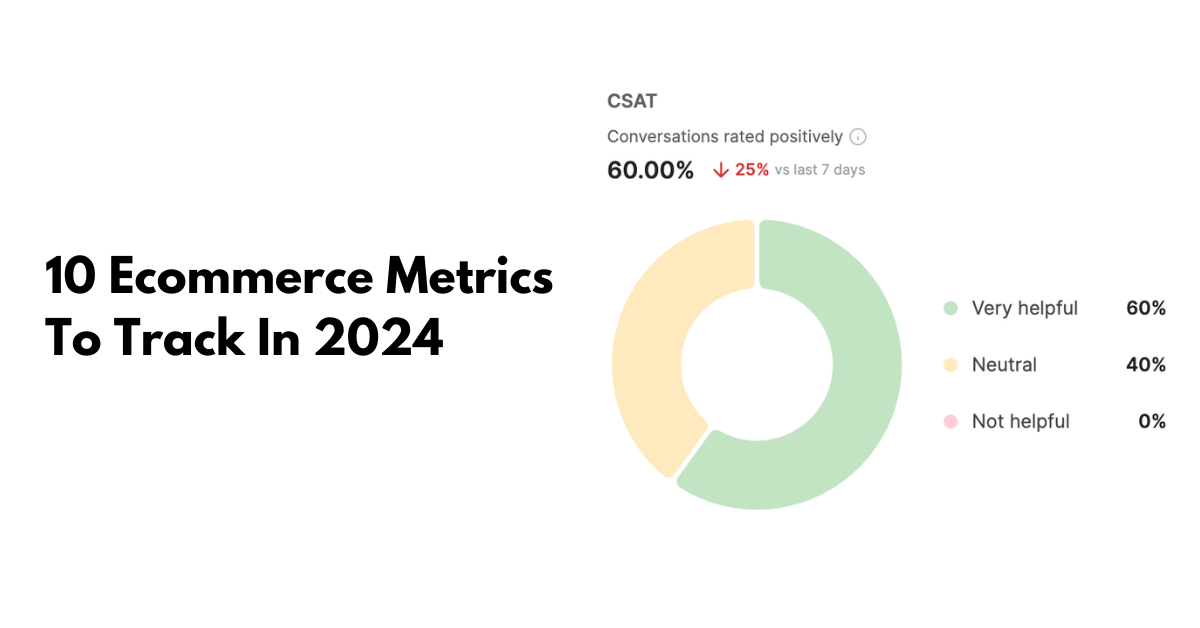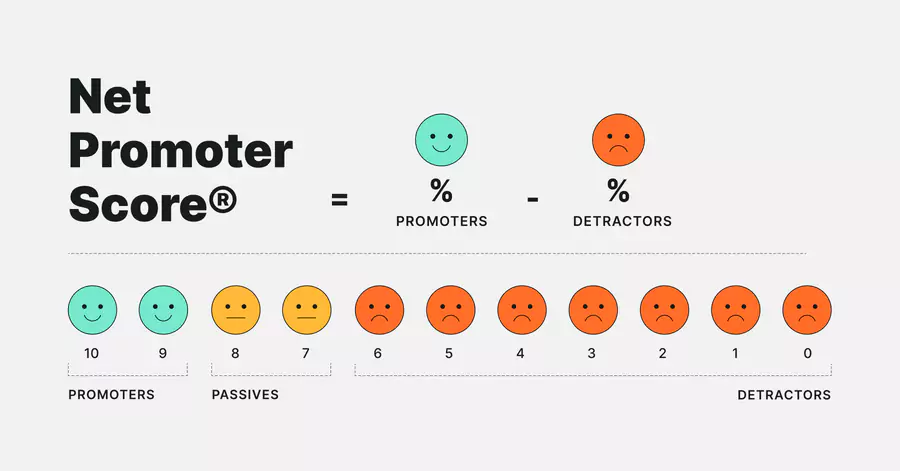10 Ecommerce Metrics To Track In 2024

Understanding which metrics to track is crucial for any ecommerce business aiming for growth in 2024. As the online marketplace continues to evolve, having clear, actionable insights into your store's performance can make all the difference.
In this blog, we'll explore the 10 best ecommerce metrics to track that will help you navigate the changing landscape, improve your strategies, and ultimately boost your sales. By focusing on these key indicators, you'll be better equipped to make informed decisions and drive your business forward.
Ecommerce Metrics: Overview
Ecommerce metrics are crucial indicators that help businesses understand their online performance, customer behavior, and overall market trends. These metrics provide valuable insights into various aspects of an ecommerce operation, from sales and marketing effectiveness to customer satisfaction and operational efficiency. By regularly tracking and analyzing these metrics, businesses can make informed decisions, identify areas for improvement, and implement strategies that enhance growth and profitability.
Types Of Ecommerce Metrics
Here are three important types of ecommerce metrics:
Ecommerce Customer Experience Metrics
These metrics track how easy and enjoyable it is for customers to shop on your website. They include:
Page load time: How long it takes for a page on your website to load.
Site search usage: How often customers use the search bar on your website.
Mobile conversion rate: The percentage of mobile visitors who make a purchase.
Customer satisfaction score (CSAT): A measure of how satisfied customers are with their experience on your website. You can collect CSAT scores through surveys or by asking customers to rate their experience on a scale of 1 to 5.
Ecommerce Conversion Metrics
These metrics track how many visitors to your website make a purchase. They include:
Conversion rate: The percentage of visitors who make a purchase.
Average order value (AOV): The average amount of money that customers spend per order.
Customer acquisition cost (CAC): The cost of acquiring a new customer.
Return on ad spend (ROAS): The amount of revenue you generate for every dollar you spend on advertising.
Ecommerce Funnel Metrics
These metrics track the different stages of the customer journey, from when a visitor first arrives on your website to when they make a purchase. They include:
Traffic sources: Where your website traffic is coming from (e.g., search engines, social media, email marketing).
Bounce rate: The percentage of visitors who leave your website after viewing only one page.
Cart abandonment rate: The percentage of visitors who add items to their shopping cart but do not complete the checkout process.
Checkout abandonment rate: The percentage of visitors who start the checkout process but do not complete it.
Why Ecommerce Metrics Tracking Is Important?
Tracking ecommerce analytics metrics is crucial for the success and growth of an online business. Here are several reasons why it is important:
Performance Measurement
Ecommerce metrics allow businesses to measure the performance of their online store. Metrics like conversion rate, average order value, and customer acquisition cost provide insights into how well the store is performing and where improvements are needed.
Customer Insights
Tracking metrics helps in understanding customer behavior and preferences. Data on metrics like bounce rate, session duration, and cart abandonment rate can reveal how customers interact with the site, what they find appealing, and where they face issues.
Marketing Effectiveness
Metrics such as return on investment (ROI), cost per click (CPC), and click-through rate (CTR) help in evaluating the effectiveness of marketing campaigns. This allows businesses to optimize their marketing strategies, allocate budgets efficiently, and enhance their marketing ROI.
Inventory Management
Ecommerce metrics like inventory turnover rate and stock-out rate assist in managing inventory more effectively. By tracking these metrics, businesses can ensure they have the right amount of stock, avoid overstocking or stockouts, and reduce holding costs.
Revenue Tracking
Metrics such as gross profit margin, net profit margin, and revenue growth rate are essential for tracking financial health. They provide a clear picture of the profitability of the business and help in making informed financial decisions.
Customer Retention
Tracking metrics like customer lifetime value (CLV), repeat purchase rate, and churn rate helps in understanding and improving customer retention. Businesses can identify loyal customers and implement strategies to enhance customer satisfaction and loyalty.
Operational Efficiency
Ecommerce performance metrics related to shipping time, order fulfillment rate, and return rate are crucial for assessing operational efficiency. Improving these metrics can lead to better customer experiences and increased customer satisfaction.
Competitive Advantage
By regularly tracking and analyzing ecommerce metrics, businesses can stay ahead of competitors. key ecommerce metrics provide insights into market trends and consumer preferences, allowing businesses to adapt quickly and effectively.
Informed Decision-Making
Data-driven decision-making is a significant advantage of tracking ecommerce metrics. Reliable data helps in making strategic decisions that are based on evidence rather than intuition.
Goal Setting and Benchmarking
Online business metrics provide a basis for setting realistic goals and benchmarks. Businesses can track their progress over time, measure against industry standards, and continuously strive for improvement.
10 Ecommerce Metrics Examples
Here are the 10 ecommerce metrics powered by Manifest AI, an AI shopping assistant for Shopify stores. These are original metrics by Komfort Kissen who is solving their customer queries with Manifest AI.
Conversion Rate

The percentage of website visitors who complete a desired action, such as making a purchase.
Importance: The conversion rate is a direct indicator of how effective your website is at turning visitors into customers. A higher conversion rate means your site is successfully convincing visitors to make purchases.
Actionable Insight: Optimize product pages, simplify the checkout process, and use A/B testing to improve this rate.
Sales

Total revenue generated from transactions over a specified period.
Importance:
Tracking sales helps gauge the overall health and success of your ecommerce business. It reflects the effectiveness of marketing campaigns and pricing strategies.
Actionable Insight:
Analyze trends in sales data to identify peak purchasing times and successful product lines. Use this information to optimize your inventory and marketing efforts for increased sales.
Add to Cart Rate

The percentage of visitors who add at least one item to their shopping cart.
Importance: A higher Add to Cart Rate indicates effective engagement and interest from visitors, reflecting positively on product appeal and site usability. It's crucial for moving customers along the buying process.
Actionable Insight: Enhance product visibility and appeal through clear, compelling product descriptions and images. Optimize the ease of the shopping process and consider incentives like limited-time offers to increase this rate.
CSAT Score

Represents the level of customer satisfaction with your service or product.
Importance: A high CSAT score indicates happy customers, which can lead to repeat business and positive word-of-mouth, essential for sustaining growth. Monitoring CSAT helps identify areas of the customer experience that need improvement.
Actionable Insight: Regularly gather feedback through surveys post-purchase or service interactions. Use insights to refine customer service processes, product quality, and overall shopping experience.
Top performing products

The products generate the most sales or highest revenue in your ecommerce store.
Importance: Identifying top-performing products allows you to understand what appeals most to your customers. This insight can guide inventory decisions, marketing focus, and product development.
Actionable Insight: Highlight these products through featured listings on your site and targeted marketing campaigns. Consider stocking similar items or variants to capitalize on their popularity.
Return on Investment (ROI)

The ratio of net profit to the cost of investment is often expressed as a percentage.
Importance: ROI helps in evaluating the profitability of investments, including marketing campaigns, new products, or business expansions.
Actionable Insight: Track and analyze the performance of various marketing channels and campaigns to allocate resources to the most effective ones.
Website Visits

The total number of times customers visit your ecommerce site.
Importance: Tracking website visits helps gauge the overall interest in your store and effectiveness of marketing efforts. It indicates potential sales opportunities and helps assess customer engagement levels.
Actionable Insight: Enhance your marketing campaigns to drive more traffic, optimize your site's SEO to attract more visits, and improve site usability to encourage repeat visits.
Revenue Per Visitor (RPV)

The average revenue generated per visitor to your site.
Importance: RPV combines traffic and sales data, offering a comprehensive view of how much value each visitor brings.
Actionable Insight: Enhance user experience, improve site navigation, and use personalized product recommendations to increase RPV.
Repeat Purchase Rate

The percentage of customers who make more than one purchase within a specific period.
Importance: This metric indicates customer loyalty and satisfaction, showing how successful your business is at retaining customers.
Actionable Insight: Develop loyalty programs, offer personalized discounts, and maintain excellent customer service to boost repeat purchase rates.
Net Promoter Score (NPS)

A measure of customer loyalty and satisfaction based on their likelihood to recommend your store to others.
Importance: NPS provides insights into customer sentiment and can predict future growth through customer referrals.
Actionable Insight: Collect feedback to understand detractors' issues, improve overall customer experience, and encourage promoters to spread positive word-of-mouth.
Conclusion
In conclusion, any online firm hoping for long-term growth and success in 2024 must keep an eye on these ten crucial ecommerce KPIs. Metrics such as conversion rate, average order value, cart abandonment rate, customer lifetime value, and others can provide organizations with important information about consumer behavior, help them optimize their marketing tactics, increase user experience, and ultimately boost profitability.
Leveraging data-driven insights from these indicators will help firms stay competitive, adjust to shifting market trends, and forge closer bonds with their clients as the e-commerce industry continues to change.

.png)
